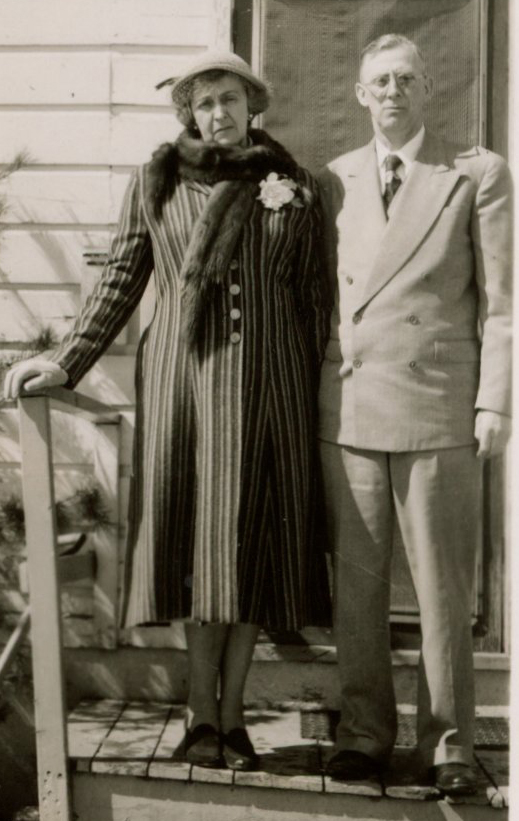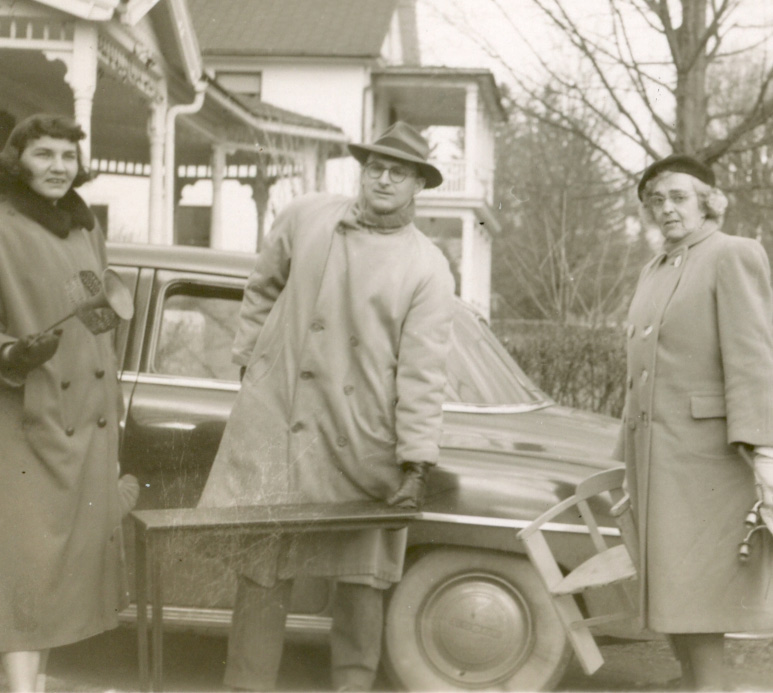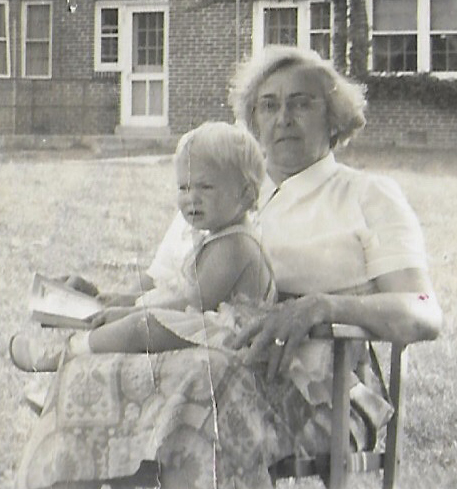
Rob and Hazel Belfit,
A Short Biography
Written by Ashley J. Freinberg
Ashley J. Freinberg is the great-granddaughter of Robert & Hazel Belfit. She is a Los Angeles-based visual artist and university educator with a Master of Fine Arts (MFA) degree in Painting from Boston University. Always living with Belfit Shaker material, her goal is to place Rob and Hazel’s relationship with the Shakers in the proper light.
Robert William Belfit was born on November 16, 1891, in Watertown, Connecticut, to Charles and Nellie Cowell Belfit. Hazel Theodora Prentiss was born on January 28, 1896, in Pittsfield, Massachusetts, to Benjamin and Dorothea Wackler Prentiss. Both were third-generation New Englanders with lifelong connections to their respective hometowns. The Belfits trace back to the region as early as the 1860s, while the Prentisses were early settlers of Pittsfield. Rob and Hazel met in 1915, in Pittsfield, living a half mile from each other, while Rob was working at General Electric. Marrying in 1918, they continued living in Pittsfield where Hazel gave birth to their first child. Around 1922, they returned to Rob’s hometown of Watertown where Rob worked for 41 years as a Chemical Engineer/Researcher for Scovill Manufacturing. They had three children and eight grandchildren. Rob died on July 14, 1980, at the age of 88. Hazel died on November 12, 1981, at the age of 85, after 61 years of marriage. Both are buried in Watertown, Connecticut.
Hazel and Rob were devoted to antique acquisitions and outings. Hazel first, Rob second as he put it, and enjoyably together. Pulling up at Mt. Lebanon in 1923, the North Family directed them to go down the road to the South Family. There, Brother William Perkins along with Lillian Barrow sold them their first Shaker chair for their young daughter for $12. Later, their son Bob Belfit would reminisce how Lillian would have milk and cookies for him on his arrival as a young boy and let him explore her machine shop. They pursued this relationship, amongst numerous others with Eldresses and Brethren: Rosetta Stephens, Lillian Barlow, Sarah Collins, Ethel Peacock, Mary Dahm, and Mildred Barker, that spanned a half-century of profound friendship throughout their lifetimes. From these decades into the late 70s, the Belfits would drive hundreds of miles to see these dearest friends and take photographs, bring tomatoes from their garden, share newspapers, books, and stories from their world, bringing their three children, parents, nieces, and later grandchildren along the way.

Hazel and Rob purchased and were gifted items. “We never tried to buy anything they were using. When members died, furniture sometimes became available,” wrote Rob Belfit in his 1971 unpublished memoir. The Belfits focused on collecting Shaker pieces that endeared, warmed, and created joy in their lifestyle, for themselves and their extended family. Rob continued, “we were primarily interested in acquiring antiques for our own use in furnishing our home.”
They purchased pieces that were linked to and used by a close Brother or Sister, from large to small, such as muffin tins and dustpans, cabinets, and tables that belonged to Rosetta, Ethel, and Lillian. There were no frivolous purchases or Shaker items in excess in their collection. Conversely, they amassed hundreds of antiques, art, and furniture of glorious beauty that varied in their cultural origin, appearance, function, and price. In addition to Mount Lebanon, the Belfits forged relationships with the Shakers of the Watervliet, New York, Hancock, Massachusetts, Canterbury, New Hampshire, and Sabbathday Lake, Maine, communities.
“Whenever we wanted a relief from the turmoil of our ‘worldly’ civilization we visited our relatives and friends in Pittsfield and then on to Mount Lebanon,” wrote Rob Belfit in 1971. Even during World War II fuel shortages, Rob and Hazel would, “would conserve our gasoline for a visit to Eldress Rosetta and Sister Lillian Barlow where serenity was supreme.”
In many of these communities, Rob and Hazel were benefactors in numerous documented ways. According to correspondence with Mildred Barkers and Rosetta Stephens, they frequently sent checks to the villages. As Charter Members, “Friends of the Shakers” at Sabbathday Lake, they worked to help preserve the Sabbathday Lake, Maine, community. They were there at the beginning of Shaker exhibitions, such as the Shaker Industries and Albany State Museum, New York, in 1940. They fastidiously kept pamphlets and ephemera of these events, along with any newspaper clipping, obituary, or article regarding the Shakers, and sometimes mailed them to their children. These were often sent inside a letter that was decorated with a hand-carved, linoleum-printed card lined with a poem by Hazel yearly for decades for Christmas.
Hazel embodied an intimate relationship with the Shaker Sisters, independent from her husband. Exchanging letters and cards with Ethel Peacock, Rosetta Stephens, Mildred Barker, Mary Dahm, and Jennie Wells depicts a friendship of particular closeness. They had common viewpoints to share. Evidenced in the large volume of correspondence, that nearly always is concluded in a closing statement with “All my love,” Ethel Peacock wrote to Hazel in 1950 commenting, “I am glad to meet someone like you who appreciates what we are all trying to do.” She knitted sweaters for the sisters, gifted self-drafted patterns of her cozies to be used and recreated in the sisters’s shop, amongst others. Hazel shared her love of the Shakers with her community by giving talks to women’s and church groups along with the public, titled, “Shaker Ways and Shaker Days,” around the greater New England Area in the 50s, 60s, and 70s. As a grandmother, she was generous, gifting her granddaughter with Shaker smalls such as lined sewing baskets, dress pins, hand mirrors, and piles of books over many years. Cherishment of fine art and these special objects, frequenting museums together, and how to care for them, filled their time together.
Archiving, maintaining, and preserving were of utmost importance to Rob and Hazel. Rob’s longtime primary career was as an Organic Chemist at Scovill Manufacturing in Metals Research. Additionally, He was Chairman of the Watertown Library Association for 47 years. The books held there were 1200 volumes of early first edition rare books such as almanacs, works by Ben Franklin, Thomas Jefferson, etc. Together with Hazel, they worked on the material conversation of these precious objects. Rob’s knowledge aided the Shakers in material guidance such as finishes, shellacs, and glues. They had a relationship of reciprocity. For example, he secured a new shellac for Brother William from William Zinsser & Co. that was unavailable to the public. At Scovill, he developed numerous patents worldwide for copper, brass, and a variety of chemical processes.

Rob’s youngest son, Robert William Belfit Jr, “Bob” was a third-generation chemist whose childhood included running through fields with Brother Curtis and his dog, sprinting across bridges with Sarah Collins, and getting into tools at Lillian Barlow’s shop. After college and the army, Bob married Margo and later lived in Midland, Michigan, where they enjoyed treasuring these objects that Bob’s parents bestowed upon them from a lifetime of collecting. Bob was the storyteller between them, telling of construction, distinction, and ability to recognize differences between pieces and objects that varied between villages. Margo kept the collection as Hazel and Rob would have wanted them—a chair and table at the front entry, a light stand with candles next to the living room couch. All arranged and moderated with Margo’s flair for crisp and creamy whites set with dusky Shakeresque blues. Hazel and Rob visited them in Midland, Michigan, yearly, and inevitably Hazel had input and influence on the decor.
Bob and Margo had one daughter, Barcie Barrie Belfit, whom Hazel affectionately called “younger than springtime.” “For she was born last April, not too far from May,” lovingly wrote Hazel. Shaker was enmeshed in Barcie’s upbringing, living with these pieces her lifetime. The lineage of persistent preciousness and care remained with Barcie permanently.
Barcie, like Hazel, was a maker. Throwing hundreds of pounds of clay, making, selling, and exhibiting thousands of functional ceramics, she utilized experimentation with glazes and finishes, much like her grandfather, while pursuing her passion. Aesthetically, her pottery referenced Shaker color and finishes of wood. The forms and decoration of her vessels were minimal, always functional, frequently utilitarian, and durable, with inherent beauty. Barcie loved to observe and spend time with her Shaker collection alongside her husband Bob, (also a Robert), and their children, Jonathan and Ashley.
Daughter Ashley continues to follow in her great-grandmother and mother’s pursuits and ongoing curiosity of material history, construction, and conservation. Ashley is a visual artist. Currently, she is manifesting multiple years of archiving, discovering, and assessing century-old documents, photos, letters, and ephemera pertaining to the Shakers and the Belfits that shed light on the accomplishments and efforts of her great grandparents in the context of Shaker history.
Photographs (descending):
Hazel and Robert, 1952. Collection of Ashley J. Freinberg
Margo, Bob, and Hazel Belfit, 1952. Collection of Ashley J. Freinberg
Barcie Belfit Freinberg, 1954-1955. Collection of Ashley J. Freinberg
Resources cited:
Robert William Belfit, unpublished manuscript, November 16, 1971. Collection of Ashley J. Freinberg
Robert William Belfit, Jr., unpublished manuscript, 1983. Collection of Ashley J. Freinberg
Letter from Sister Ethel Peacock to Hazel Belfit, n.d. Collection of Ashley J. Freinberg
